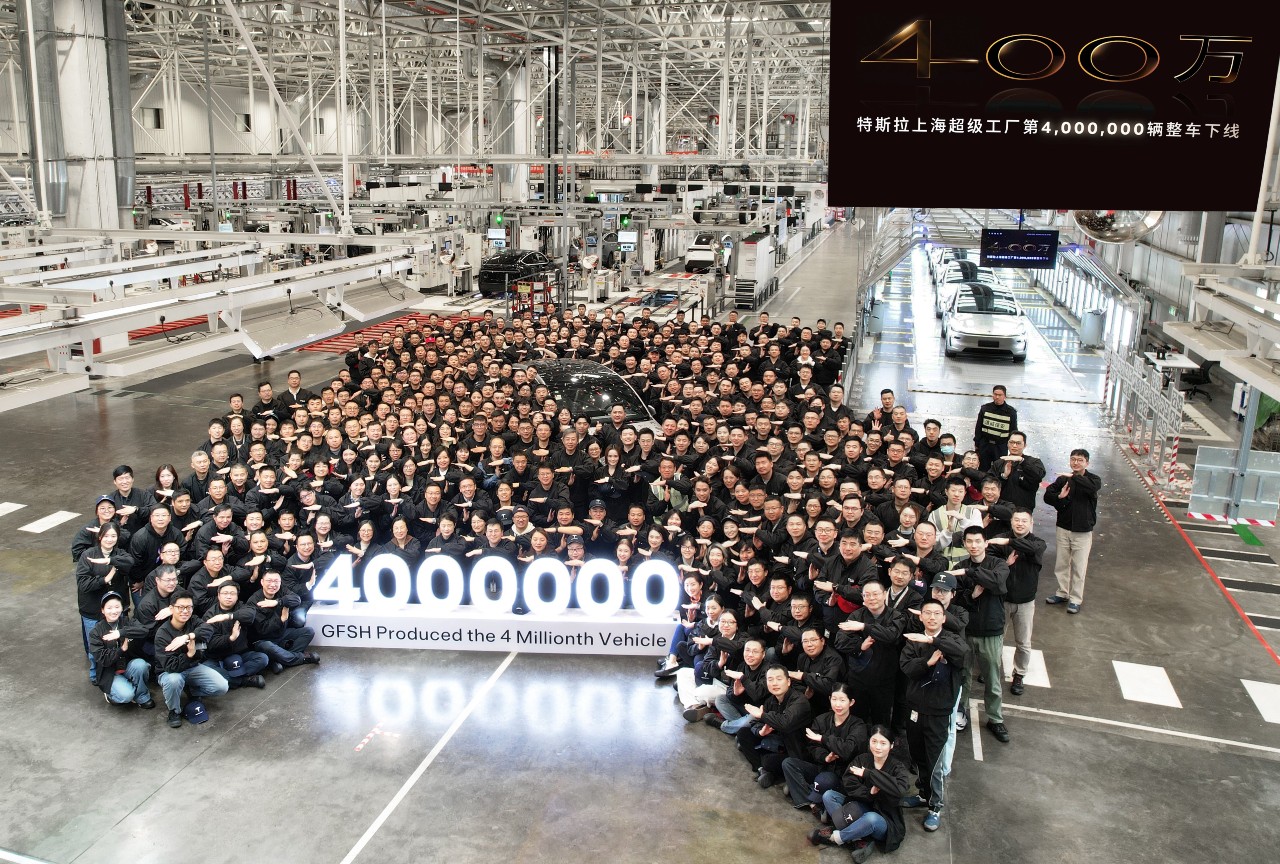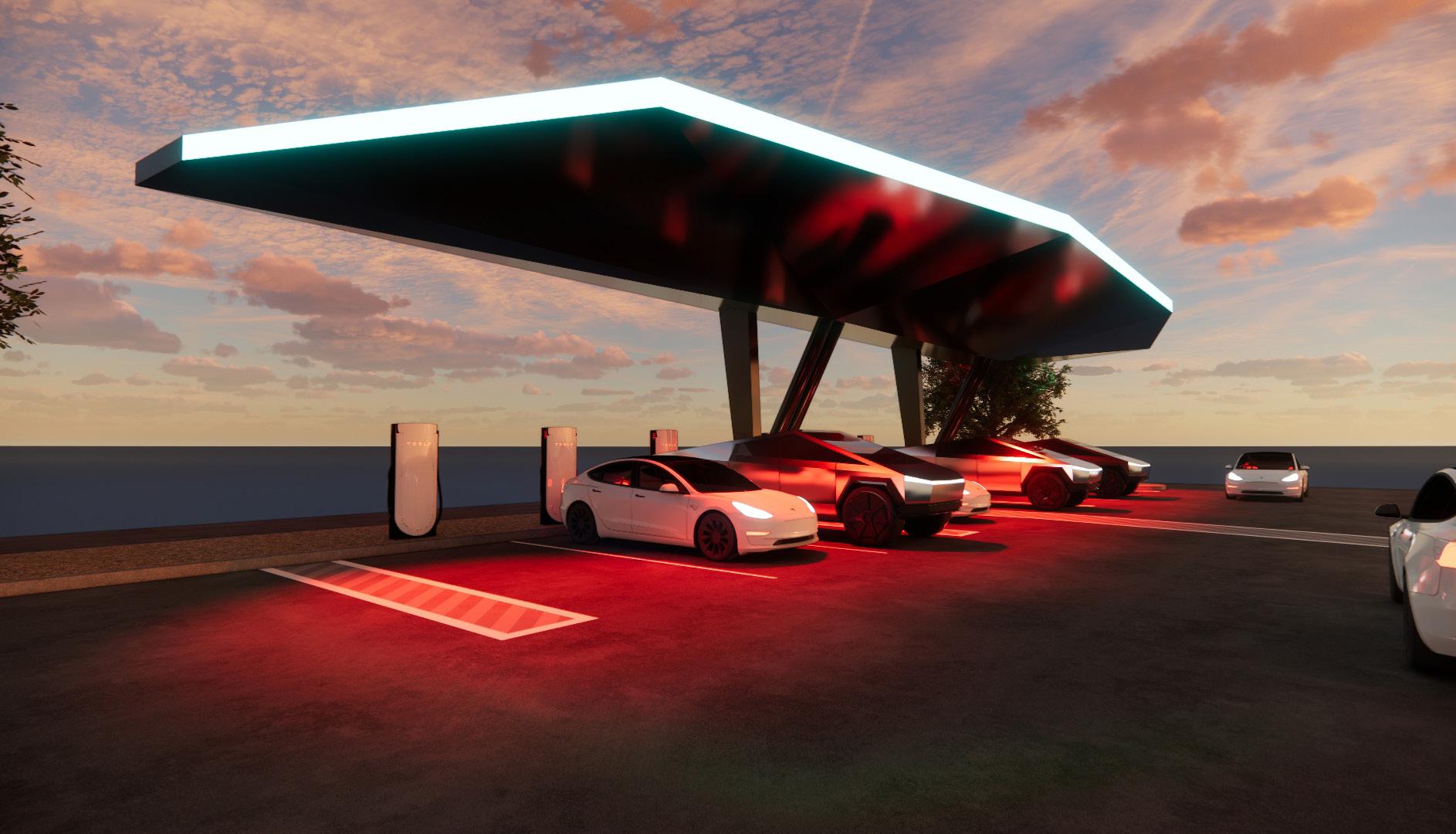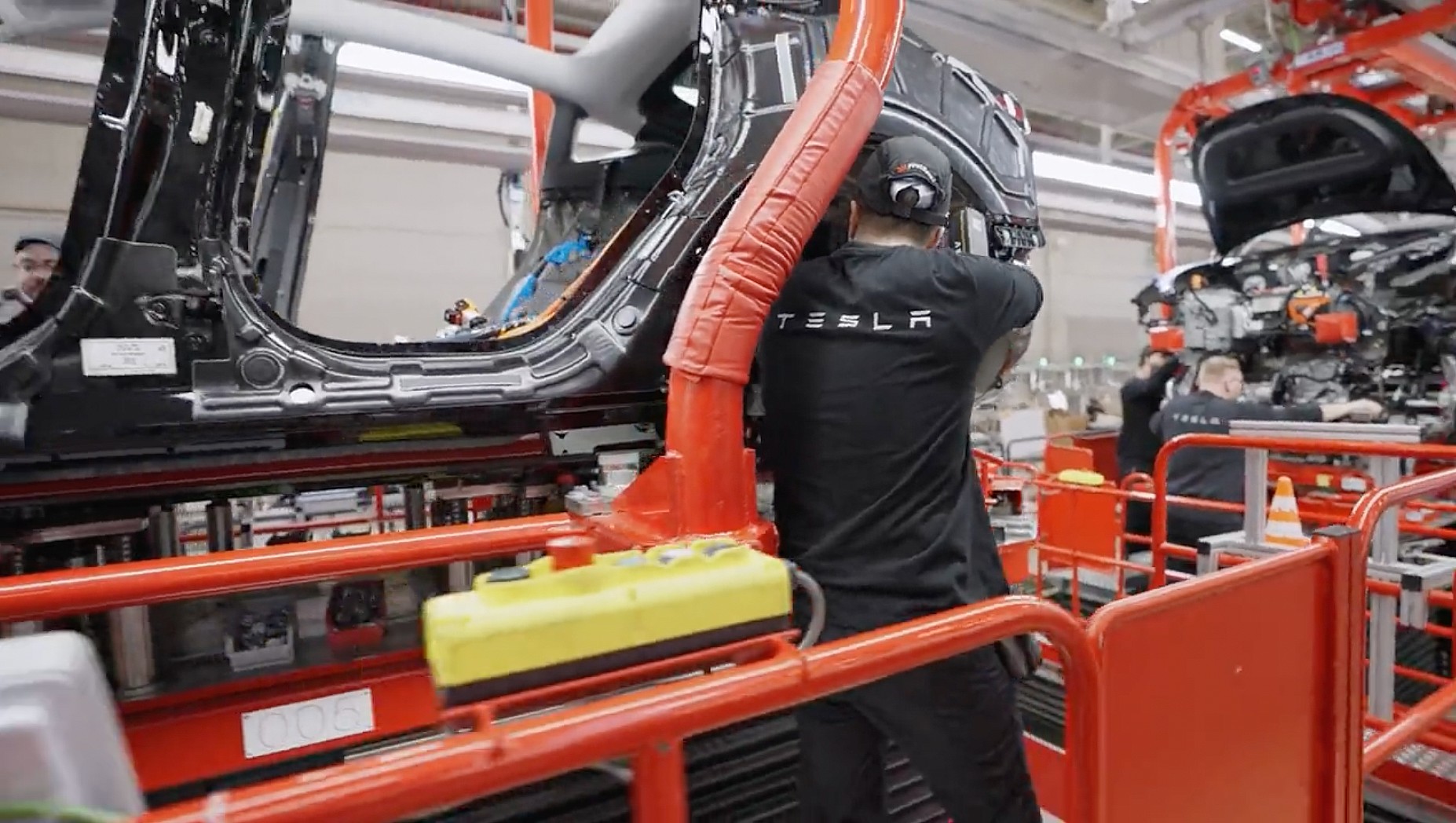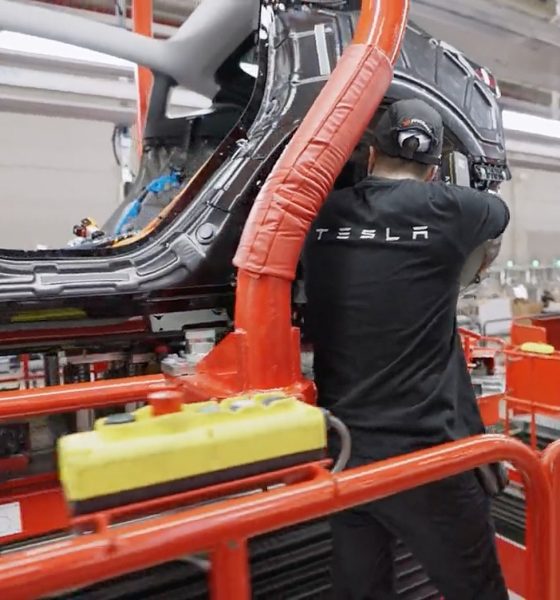Tesla gave a series of fresh, new looks inside Giga Berlin, its electric vehicle production facility located in Germany. The videos show how the factory is truly “the machine that builds the machine,” as automation, as well as a few helpful hands on the manufacturing line, help produce its products.
Tesla Giga Berlin has produced the Model Y for just under a year now, reaching a run rate of greater than 250,000 vehicles per year. The facility finally produced roughly 3,000 vehicles per week by the end of Q4, helping Tesla maintain a significant market share in Germany and the European market as a whole.
Today, Tesla gave a fresh look inside Giga Berlin, showing everything from casting and stamping to its “world-class” paint shop and general assembly lines.
Casting Lines
Tesla utilizes the IDRA Giga Press in Berlin, just as it does at other factories, to not only make manufacturing more efficient but also improve vehicle quality and safety.
Tesla shared multiple videos displaying the numerous processes of the casting design for the Model Y. “13 different body parts are stamped with a total of 7,300 tons of force, in a press line that runs at up to 16 parts per minute,” the automaker said. Additionally, Tesla showed portions of the rear casting process, which eliminated over 70 parts and refine the manufacturing process for the Model Y.
Rear chassis underbody pieces are cast in single pieces using a custom aluminum alloy, replacing 70+ metal parts pic.twitter.com/Ka0OnHEW1X
— Tesla (@Tesla) February 13, 2023
Stamped parts and castings are welded together by more than 600 robots. The car is lifted into the paintshop by “Godzilla,” which Tesla said is “one of the largest industrial robots ever.
Rear chassis underbody pieces are cast in single pieces using a custom aluminum alloy, replacing 70+ metal parts pic.twitter.com/Ka0OnHEW1X
— Tesla (@Tesla) February 13, 2023
Paint Shop
Tesla has always said that the paint shop inside Giga Berlin would be its best yet. Referring to it as “world-class” before it was even operational, the automaker has utilized the facility to roll out new colors in the European market, including Quicksilver and Midnight Cherry Red:
“Giga Berlin is home to our most advanced paint system yet, enabling multi-layer painting for depth, dimension & a hand-painted look.”
Giga Berlin is home to our most advanced paint system yet, enabling multi-layer painting for depth, dimension & a hand-painted look pic.twitter.com/W4mCZWfF7D
— Tesla (@Tesla) February 13, 2023
Tesla has struggled with paint quality at its other factories, but Giga Berlin has undoubtedly helped as it utilizes a series of high-quality paint and better processes to improve its look. Tesla filed to upgrade paint shops in Fremont, where some quality concerns arose several years ago.
General Assembly Line
Relying on both automation and humans, Tesla’s General Assembly line at Giga Berlin is where the final touches are put into place, and the Model Y truly takes shape. Over 1,000 people build the Model Y at any given time, installing HVAC, power electronics, drive units, and other elements.
CEO Elon Musk said in the past that he relied too much on automation to get things done with production, and humans were “underrated.”
The new look at Giga Berlin shows the cohesiveness between both robots and humans, which helps to complete the entire production process.
Finally, the vehicle moves to General Assembly, where seats, HVAC, power electronics, drive units & more are installed, using 20+ automated stations.
This is our biggest shop by headcount—on any given shift, 1k+ people are helping build Model Y pic.twitter.com/IgSrCpH5DR
— Tesla (@Tesla) February 13, 2023
The videos truly encapsulate how “the machine” that is Giga Berlin helps build “the machine” that is the Model Y. Tesla has refined its manufacturing processes to take advantage of both automation and humans.
I’d love to hear from you! If you have any comments, concerns, or questions, please email me at joey@teslarati.com. You can also reach me on Twitter @KlenderJoey, or if you have news tips, you can email us at tips@teslarati.com.

News
Tesla announces major milestone at Gigafactory Shanghai
First deliveries started in December 2019, with the first units being given to employees. By the end of 2020, the plant was building cars at a run rate of around 150,000 vehicles annually.

Tesla has announced a major milestone at its Chinese manufacturing facility, Gigafactory Shanghai, confirming on Monday that it had built its four millionth vehicle.
Tesla Gigafactory Shanghai first started building cars back in October 2019 with Model 3 assembly, just ten months after the company broke ground on the plant’s 86-hectare piece of land.
First deliveries started in December 2019, with the first units being given to employees. By the end of 2020, the plant was building cars at a run rate of around 150,000 vehicles annually. Production continued to ramp up, and by September 2023, less than three years after it started building Tesla’s EVs, it had built its two millionth vehicle.
Fast forward to December 2025, and Tesla has confirmed that four million cars have rolled off of production lines at the plant, a major milestone in the six short years it has been active:
Produced our 4 millionth vehicle at Gigafactory Shanghai🎉
Thanks to all our owners and supporters❤️ pic.twitter.com/DayVXUr220— Tesla Asia (@Tesla_Asia) December 8, 2025
The capacity at Giga Shanghai is exceeding 950,000 vehicles per year, and this year, the company has delivered 675,000 cars through the first three quarters. It is also the only plant to manufacture the Model Y L, a longer wheel-based configuration of the all-electric crossover that is exclusive to the Chinese market.
Gigafactory Shanghai’s four million cars have not all stayed within the domestic market, either. For a considerable period, the factory was exporting a significant portion of its monthly production to Europe, helping Gigafactory Berlin supplement some Model Y volume and all of its Model 3 deliveries. This is due to the Berlin plant’s exclusive production plans for the Model 3.
The site is one of the most crucial in the company’s global plans, and Gigafactory Shanghai’s incredible pace, which has led to four million production units in just about six years. It’s fair to say that it won’t be long until we’re seeing Tesla celebrate the plant’s five millionth vehicle produced, which should happen sometime late next year or in early 2027, based on its current manufacturing pace.
The company also builds the Megapack on the property in an adjacent Megafactory.
News
Tesla gamifies Supercharging with new ‘Charging Passport’
It will also include things like badges for special charging spots, among other metrics that will show all of the different places people have traveled to plug in for range.

Tesla is gamifying its Supercharging experience by offering a new “Charging Passport,” hoping to add a new layer to the ownership experience.
While it is not part of the Holiday Update, it is rolling out around the same time and offers a handful of cool new features.
Tesla’s Charging Passport will be available within the smartphone app and will give a yearly summary of your charging experience, helping encapsulate your travel for that year.
It will also include things like badges for special charging spots, among other metrics that will show all of the different places people have traveled to plug in for range.
Tesla has just introduced “Charging Passport,” a new yearly summary of your charging.
• Charging badges: Iconic Charging badge (for visiting places like the Tesla Diner, Oasis Supercharger, etc), Explorer badge, green saver badge, etc.
• Total unique Superchargers visited
•… pic.twitter.com/c1DHTWXpj7— Sawyer Merritt (@SawyerMerritt) December 8, 2025
Tesla will include the following metrics within the new Charging Passport option within the Tesla app:
- Charging badges: Iconic charging badges for visiting places like the Tesla Diner, Oasis Supercharger, etc., Explorer Badge, and more
- Total Unique Superchargers Visited
- Total Charging Sessions
- Total Miles Added during Charging Sessions
- Top Charging Day
- Longest Trip
- Favorite Charging Locations
This will give people a unique way to see their travels throughout the year, and although it is not necessarily something that is needed or adds any genuine value, it is something that many owners will like to look back on. After all, things like Spotify Wrapped and Apple Music Replay have been a great way for people to see what music they listened to throughout the year.
This is essentially Tesla’s version of that.
With a handful of unique Superchargers already active, Tesla is also building some new ones, like a UFO-inspired location in New Mexico, near Roswell.
Tesla is building a new UFO-inspired Supercharger in the heart of Alien country
News
Tesla launches its coolest gift idea ever just a few weeks after it was announced
“Gift one month of Full Self-Driving (Supervised), which allows the vehicle to drive itself almost anywhere with minimal intervention.”

Tesla has launched its coolest gift idea ever, just a few weeks after it was announced.
Tesla is now giving owners the opportunity to gift Full Self-Driving for one month to friends or family through a new gifting program that was suggested to the company last month.
The program will enable people to send a fellow Tesla owner one month of the company’s semi-autonomous driving software, helping them to experience the Full Self-Driving suite and potentially help Tesla gain them as a subscriber of the program, or even an outright purchase.
Tesla is going to allow owners to purchase an FSD Subscription for another owner for different month options
You’ll be able to gift FSD to someone! https://t.co/V29dhf5URj
— TESLARATI (@Teslarati) November 3, 2025
Tesla has officially launched the program on its Shop. Sending one month of Full Self-Driving costs $112:
“Gift one month of Full Self-Driving (Supervised), which allows the vehicle to drive itself almost anywhere with minimal intervention. All sales are final. Can only be purchased and redeemed in the U.S. This gift card is valued at $112.00 and is intended to cover the price of one month of FSD (Supervised), including up to 13% sales tax. It is not guaranteed to cover the full monthly price if pricing or tax rates change. This gift card can be stored in Tesla Wallet and redeemed toward FSD (Supervised) or any other Tesla product or service that accepts gift card payments.”
Tesla has done a great job of expanding Full Self-Driving access over the past few years, especially by offering things like the Subscription program, free trials through referrals, and now this gift card program.
Gifting Full Self-Driving is another iteration of Tesla’s “butts in seats” strategy, which is its belief that it can flip consumers to its vehicles and products by simply letting people experience them.
There is also a reason behind pushing Full Self-Driving so hard, and it has to do with CEO Elon Musk’s compensation package. One tranche requires Musk to achieve a certain number of active paid Full Self-Driving subscriptions.
More people who try the suite are likely to pay for it over the long term.










